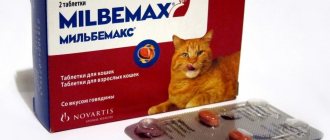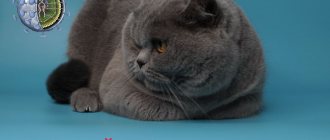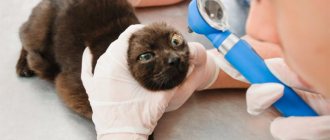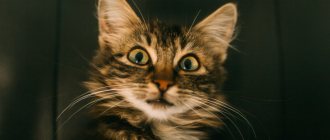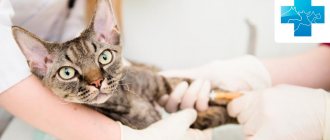Treatment of plague
Every free-ranging cat can become infected with panleukopenia at any time. Popularly, this disease is most often called “distemper”, and there is no cure for it yet. The disease very quickly affects the entire body of the animal, and a person is ready to try any means to save his beloved pet.
Symptoms of the disease. Distemper is very easy to recognize by its external signs. A sick animal begins to refuse food and water, hide from humans and have difficulty breathing. After a couple of days, obvious symptoms appear:
- very liquid green feces;
- purulent discharge from the nose;
- conjunctivitis;
- sticky wool;
- fever;
- inflamed lymph nodes.
Vodka therapy. Feline distemper is treated with vodka in 2 ways:
- Vodka or moonshine is diluted in half with water and given to the animal 5 ml per day. The effect of this treatment is visible within the next day. After a few days the pet recovers completely.
- Beat a chicken egg with 20 g of vodka and give it to the cat twice a day.
It is better to start treatment immediately if panleukopenia is suspected.
Once blood appears in the stool and vomit, the animal is likely to die.
Effect of ethanol
There is a myth that ethanol is a natural metabolite. It is not true. There is not a single reaction that occurs inside a living organism that would result in the production of ethanol. At the same time, there are many bacteria in the intestines whose task is to produce vitamins, process fiber, and some of them produce ethanol (about 3 grams per day). However, there are no such microbes inside the cat’s intestines; they exist only in the gastrointestinal tract of humans and other omnivores and herbivores.
Ethanol is a neurotoxic poison, a carcinogen and a drug that suppresses the activity of the central nervous system. Suppression of the nervous system is possible up to coma and death. The lethal dose is 5-8 ml of alcohol per kilogram of weight, that is, for a cat this is about 3-4 tablespoons of 40% vodka (it contains 20 ml) or teaspoons of pure ethanol.
Stages of intoxication with increasing dose
When consuming small doses, the “reward system” is activated, the active substance of which is dopamine. The purpose of these reactions is to motivate the animal to perform certain actions: sex, successful hunting, victory over an opponent in a territorial fight. However, you should not think that you can give your cat alcohol to “relax” it, since the “useful” dose is too small - literally 0.1 ml of ethanol or 0.3 ml of vodka. It is inconvenient to administer such an amount of alcohol even through a syringe.
A further increase in the dose depresses the activity of the central nervous system; every person has seen all these aspects more than once or even experienced it on himself:
- the brain’s ability to concentrate on various thoughts decreases, only one idea remains (usually not a good one);
- coordination of movements is impaired;
- the hunger center is stimulated, that is, the animal’s appetite increases;
- the last stage is narcotic dreamless sleep.
Sobering up
It begins simultaneously with intoxication, but since this process is slow, its result is felt only after stopping drinking alcohol.
Sobering up is directly related to the destruction of ethanol.
It goes in 2 stages:
- Decomposition of ethanol to acetaldehyde . Several systems in the body are responsible for this; the transformation of alcohol occurs both inside cells and in the blood, liver and intercellular fluid.
- Decomposition to acetic acid . This stage of decomposition takes place exclusively inside the cells, which is why the speed of this stage is greatly inhibited.
It is acetaldehyde that is the main cause of all the unpleasant sensations of a hangover. Moreover, the second stage takes much longer than the first. As a result, due to the difference in speed, acetaldehyde accumulates, which is not destroyed immediately, resulting in a hangover.
Vodka against worms
If intestinal parasites are detected, you can give your pet vodka. The therapeutic effect consists of the rapid absorption of alcohol into the walls of the gastrointestinal tract, resulting in poisoning and death of the worms. It is recommended to give half a teaspoon twice a day. Continue taking for 3 days. After this, in order to reduce the harmful effects of alcohol, feed the cat milk or fermented milk drinks for several days.
We answer your questions: how to slow down glaucoma?
Here you will find answers to questions:
1. What is glaucoma? Explain in simple words. 2. Why does glaucoma occur, what provokes its development? 3. What are the symptoms of glaucoma? 4. Why is glaucoma difficult to detect without testing? 5. What examination needs to be done to detect glaucoma? 6. I have glaucoma. How often should you visit an ophthalmologist? 7. Is glaucoma inherited? 8. What are the restrictions for patients with glaucoma? 9. Is it possible to completely cure glaucoma? 10. Is it possible to restore vision with glaucoma? 11. Is it possible to restore vision after an acute attack of glaucoma?
Answers your questions:
Nikandrova Olga Alexandrovna
Specialization: Diagnostics, glaucoma, diseases of the optic nerve and central retina Work experience: 8 years
Procedures:
more than 35,000
What is glaucoma? Explain in simple words.
Try focusing your gaze on the penultimate word of this sentence. At the same time, you simultaneously see out of the corner of your eye the space around your phone (computer). This is peripheral vision. It helps you not to stumble and to be on your guard if someone suspicious approaches you. Or see that a pedestrian has entered the roadway if you are driving. Glaucoma begins precisely by “stealing” our peripheral vision. The outflow of intraocular fluid becomes difficult, it accumulates and provokes an increase in intraocular pressure. The optic nerve is “squeezed” and the blood supply to the eye is disrupted. Increased stress on the optic nerve can cause it to atrophy, and visual images stop entering the brain. Vision, especially peripheral (side), begins to decline. The disease is dangerous because it can lead to irreversible blindness that cannot be treated, and this happens suddenly. At the same time, if diagnosed in time, glaucoma can be easily stopped: in the early and middle stages - with drops and simple procedures, in the late stage - with a simple operation. Therefore, the most important thing for glaucoma is to detect it in time and begin treatment.
Why does glaucoma occur, what provokes its development?
Among the main factors in the development of glaucoma:
- age over 40, the older you are, the higher the risk
- heredity
- severe myopia
- medium to high farsightedness
- diseases of the vascular system (atherosclerosis, coronary heart disease)
- eye injury
- diabetes
What are the symptoms of glaucoma?
If you notice any of these symptoms, please don't delay! Consult a specialist immediately to get the right treatment on time and avoid vision loss:
- blurring of the image before the eyes
- mild pain in the eye area, temple, above the eyebrow
- narrowing of the view on the sides
- the appearance of haze before the eyes
- light circles or rainbow spots around light sources
Why is glaucoma difficult to detect without testing?
Glaucoma is insidious in that it can affect up to 90% of your vision, and you won’t even notice it. The cerebral cortex has the amazing ability to fill in the gaps for which there was no information from the optic nerve with pictures from nearby areas. This natural mechanism deceives our perception and prevents us from noticing black areas of vision loss in time. And only when the “hole” in the visual field becomes so large that the compensation mechanism cannot fill it, the patient suddenly realizes that vision has deteriorated. Although, in fact, the deterioration began to occur long before that. That is why diagnostics using modern equipment is so important, allowing us to identify glaucoma at the earliest stages. When it will be enough to just prescribe special drops to cope with glaucoma.
What examination needs to be done to detect glaucoma?
Glaucoma is always accompanied by increased intraocular pressure. It sounds as if this is the only thing that needs to be measured for a correct diagnosis. In fact, only a complete comprehensive diagnosis can answer the question of whether there is glaucoma or not. A simple example: a patient has increased intraocular pressure and no other signs of glaucoma. This may be a symptom of an endocrine disorder and will require further testing to make a diagnosis.
Comprehensive vision diagnostics to identify glaucoma and check the effectiveness of prescribed treatment includes several types of studies:
- tonometry – measurement of intraocular pressure (3 types: Goldman tonometry, non-contact tonometry, contour dynamic tonometry), Pascal;
- perimetry - checking visual fields;
- gonioscopy – study of the anterior chamber angle;
- ophthalmoscopy - examination of the optic nerve head and retina;
- OCT – optical coherence tomography, layer-by-layer study of the retina and optic nerve head. Necessary for early diagnosis and follow-up.
I have glaucoma. How often should you visit an ophthalmologist?
Once the diagnosis is made, the ophthalmologist becomes your true ally in the fight against glaucoma. Schedule your visits to the ophthalmology clinic:
- to measure intraocular pressure – once every 1-3 months;
- to control the visual field – once every 3-6 months;
- to monitor the condition of the optic nerve – once every 6-12 months.
The frequency of examination is prescribed by the doctor individually for each patient. If necessary, the glaucomatologist will adjust the treatment by prescribing other eye drops or a combination of several drugs.
Is glaucoma inherited?
Unfortunately, glaucoma is indeed quite often inherited. Therefore, you should be especially attentive to your vision if you have close relatives with this diagnosis.
What are the restrictions for patients with glaucoma?
In addition to the personal recommendations on diagnostic results that you will receive from your doctor, there are some general tips:
- do not wear sweaters with a narrow neck, tight collars and ties - anything that can impede blood circulation in the neck area
- When working at a computer, with documents or when reading, take a break of 10-15 minutes every hour
- Night shifts, overtime work are undesirable, you cannot work in hot shops, with toxic substances, or in conditions of constant vibration
- try to quit smoking, it negatively affects intraocular pressure
- Avoid staying in a bent position or with your neck bent for long periods of time. For work in the garden (for example, weeding), adapt a bench.
Is it possible to completely cure glaucoma?
Unfortunately, vision loss from glaucoma is irreversible. Therefore, the main task of ophthalmologists is to identify it at the stage when increased intraocular pressure can still be compensated with special drops, procedures or simple surgery in order to protect the optic nerve and the flow of visual signals to the brain. In this case, good vision can please you for many years.
Is it possible to restore vision with glaucoma?
With glaucoma, vision deteriorates due to incipient atrophy of the optic nerve. If increased intraocular pressure is not treated in any way (with drops or procedures), then the process can occur especially quickly. Glaucoma treatment is mostly aimed at preserving existing vision. To achieve this, various procedures are performed to stimulate the optic nerve, as well as drops that control intraocular pressure. At later stages, an operation is prescribed, the essence of which is to create micropunctures to drain excess fluid from the eyeball and reduce intraocular pressure.
In any case, patients with glaucoma require a careful comprehensive examination. It is necessary to measure intraocular pressure once every 1-3 months, check the visual field once every six months, and conduct OCT of the optic nerve once a year. Depending on the results, your doctor will be able to create the most effective treatment plan for you. So that you can preserve your remaining vision for several decades.
Is it possible to restore vision after an acute attack of glaucoma?
An acute attack of glaucoma is always caused by a sharp increase in intraocular pressure. The main goal of ophthalmologists in this case is to reduce intraocular pressure as quickly as possible to restore normal blood circulation in the eye and adequate nutrition of the optic nerve. If treatment is incomplete or delayed, unfortunately, an irreversible decrease in visual acuity may occur due to the development of optic nerve atrophy. In such cases, treatment is prescribed in two directions: 1) reducing intraocular pressure to normal using drops, procedures or special surgery 2) treating optic nerve atrophy. It is, for the most part, aimed at preserving existing vision. For this purpose, procedures are used that stimulate the optic nerve, as well as drugs that improve metabolic processes in the eye, to ensure that the optic nerve receives adequate nutrition.
In any case, only an experienced glaucomatologist can determine a further strategy for preserving your vision, after all the necessary research.
Help with frostbite
In winter, cases of frostbite in furry pets are common. Most often, the tail, limbs, ears or nose are affected. The main signs of frostbite are pale skin in the area of the lesions and the appearance of dense swelling. In severe cases, the skin of the mustachioed tabby becomes covered with blisters or swelling.
Treatment with vodka. In case of significant frostbite, “fire water” comes to the aid of a loving owner. Saving a cat from exposure to low temperatures must occur in strict order:
- First, the affected areas should be washed with soap and water. The liquid should not be too cold or hot. You need to start with a temperature of +18-20°C, gradually bringing it to 40°C.
- Then the animal needs to be rubbed with vodka, gently massaging the frostbitten areas.
- After restoring blood flow to the cat, give the cat another rub.
It is important to remember that if it is not possible to bring a frostbitten pet indoors, you should place it under clothing and warm it with your own heat.
Rubbing with snow is contraindicated for animals.
Also watch the video: Is it worth treating dogs and cats with vodka:
Treatment of cats with folk remedies
One of the common diseases for which they try to treat cats with folk remedies is distemper (its correct name is panleukopenia). The distemper virus destroys the body's lymphatic tissues, causing the cat's immunity to suffer.
There is an opinion that this disease can be cured with vodka. There are “healers” who prove that they cured the plague in this way. Perhaps that kitten had a slight cold and it went away after two days.
Veterinarians are categorical: vodka does not have an antiviral effect, so it will not help with distemper. This treatment is equivalent to treating a person with vodka for erosive gastritis. In the end, vodka can simply poison an already weakened animal.
As a folk remedy, external parasites are removed from cats using diesel fuel. To do this, dilute the solarium with water, moisten the fur with this solution and put the poor animal in a bag for 10-15 minutes, leaving the head outside. It’s good if the kitten doesn’t get poisoned after such an execution.
There are many such examples that can be given. But still, despite the obvious absurdity of these examples, many people treat kittens with folk remedies. For example:
- cardiovascular diseases are treated with decoctions of lovage or tincture of hawthorn, dill or lily of the valley;
- for constipation, give castor oil or do an enema with it;
- bloating and colitis are treated in folk medicine with peppermint or dill oil;
- cystitis is treated with decoctions or infusions of bearberry leaves, nettles, and birch leaves;
- infusion of elderberry flowers and oregano herb helps with urinary problems;
- traditional medicine suggests removing intestinal parasites with infusions of tansy, wormwood, and cloves;
- ringworm - for ringworm, rub the infected areas with a mixture of yellow sulfur and oil. Ringworm simplex is smeared alternately with brilliant green and iodine. Traditional healers claim that if lichen is lubricated with cranberry juice, it will disappear in 3 days.
IMPORTANT! There are no studies that would show that the listed remedies and infusions are truly effective in treating the corresponding ailments. Moreover, in some cases, their use can lead to severe intoxication of the cat’s body, which can lead to serious consequences, including death. Thus, Murkoshi specialists warn that by self-medicating, you can harm your pet so much that even a veterinarian will not be able to save him after such treatment.
Treatment of erectile dysfunction: honestly about a very delicate problem
Even completely healthy men can experience erection problems for a variety of reasons.
Most often in such cases, erectile dysfunction occurs. It is often also called impotence, but from a medical point of view these are slightly different problems. Erectile dysfunction in men manifests itself in the form of a decrease in the quality and duration of an erection, as well as difficulties that appear before its occurrence. This is a broader concept than impotence, which means the inability to perform sexual intercourse, that is, the complete absence of an erection. Because of this, treatment for erectile dysfunction and impotence may differ. It all depends on the cause of the problem and how advanced it is, so it is important to see a doctor in time.


